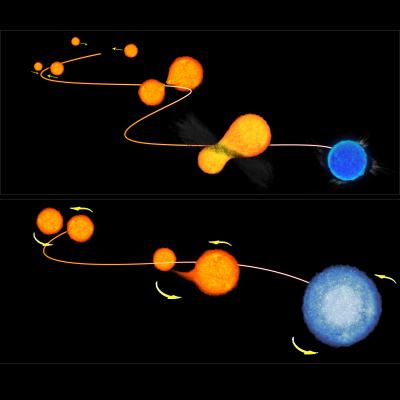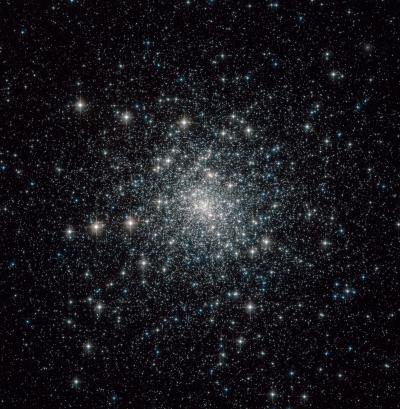Oddly, blue stragglers appear to regress from 'old age' back to a hotter and brighter 'youth', gaining a new lease on life in the process - a cosmic facelift.
A team of astronomers recently used Hubble to study the blue straggler star content in Messier 30, which formed 13 billion years ago and was discovered in 1764 by Charles Messier. Located about 28,000 light-years away from Earth, this globular cluster, a swarm of several hundred thousand stars, is about 90 light-years across.

Illustration demonstrates the two ways that blue stragglers in globular clusters form. The upper illustration shows the collision model where two low-mass stars in an overcrowded environment experience a head-on collision, combining their fuel and mass and to form a single hot star. The lower illustration depicts the "vampire" model consisting of a pair of stars that undergo a transformation, with the lower-mass star draining its larger-mass companion of hydrogen that fuels its rebirth. Credit: NASA/ ESA
Although blue stragglers have been known since the early 1950s, their formation process is still a puzzle for astrophysicists.
"It's like seeing a few kids in the group picture of a rest-home for retired people. It is natural to wonder why they are there," says Francesco Ferraro from the University of Bologna in Italy, lead author of the study that will be published this week in Nature.
Researchers have been studying these stars for many years and knew that blue stragglers are indeed old. They were thought to have arisen in a tight binary system. In such a pair, the less massive star acts as a "vampire", siphoning fresh hydrogen from its more massive companion star. The new fuel supply allows the smaller star to heat up, growing bluer and hotter — behaving like a star at an earlier stage in its evolution.
The new study shows that some of the blue stragglers have instead been rejuvenated by a sort of "cosmic facelift", courtesy of cosmic collisions. These stellar encounters are nearly head-on collisions in which the stars might actually merge, mixing their nuclear fuel and re-stoking the fires of nuclear fusion. Merged stars and binary systems would both be about twice the typical mass of individual stars in the cluster.

This image of Messier 30 (M 30) was taken by Hubble's Advanced Camera for Surveys (ACS). Messier 30 formed 13 billion years ago, is located about 28,000 light-years away from Earth, and is about 90 light-years across. Although globular clusters such as this one are mainly populated by old stars, the crowded field of stars leads to some old stars apparently reclaiming their youth in the form of blue stragglers. Researchers using data from Hubble's now-retired Wide Field Planetary Camera 2 (WFPC2) have identified two types of blue stragglers in Messier 30: those that form in near head-on collisions with one another and those that are in twin (or binary) systems where the less massive star siphons "life-giving" hydrogen from its more massive companion. Credit: NASA/ ESA
"Our observations demonstrate that blue stragglers formed by collisions have slightly different properties from those formed by vampirism. This provides a direct demonstration that the two formation scenarios are valid and that they are both operating simultaneously in this cluster," says team member Giacomo Beccari from ESA.
Using data from the now-retired Wide Field Planetary Camera 2 (WFPC2) aboard Hubble, astronomers found that these "straggling" stars are much more concentrated towards the centre of the cluster than the average star. "This indicates that blue stragglers are more massive than the average star in this cluster," says Ferraro. "More massive stars tend to sink deep into the cluster the way a billiard ball would sink in a bucket of honey."
The central regions of high density globular clusters are crowded neighbourhoods where interactions between stars are nearly inevitable. Researchers conjecture that one or two billion years ago, Messier 30 underwent a major "core collapse" that started to throw stars towards the centre of the cluster, leading to a rapid increase in the density of stars. This event significantly increased the number of collisions among stars, and favoured the formation of one of the families of blue stragglers. On the other hand, the increase of stellar crowding due to the collapse of the core also perturbed the twin systems, encouraging the vampirism phenomenon and thus forming the other family of blue stragglers.
"Almost ten percent of galactic globular clusters have experienced core collapse, but this is the first time that we see the effect of the core collapse imprinted on a stellar population," says Barbara Lanzoni, University of Bologna.





Comments